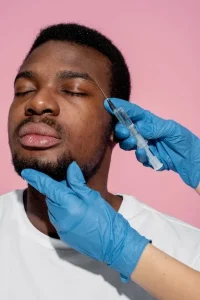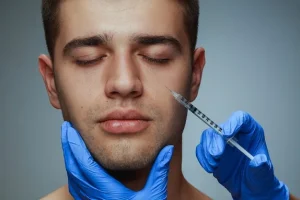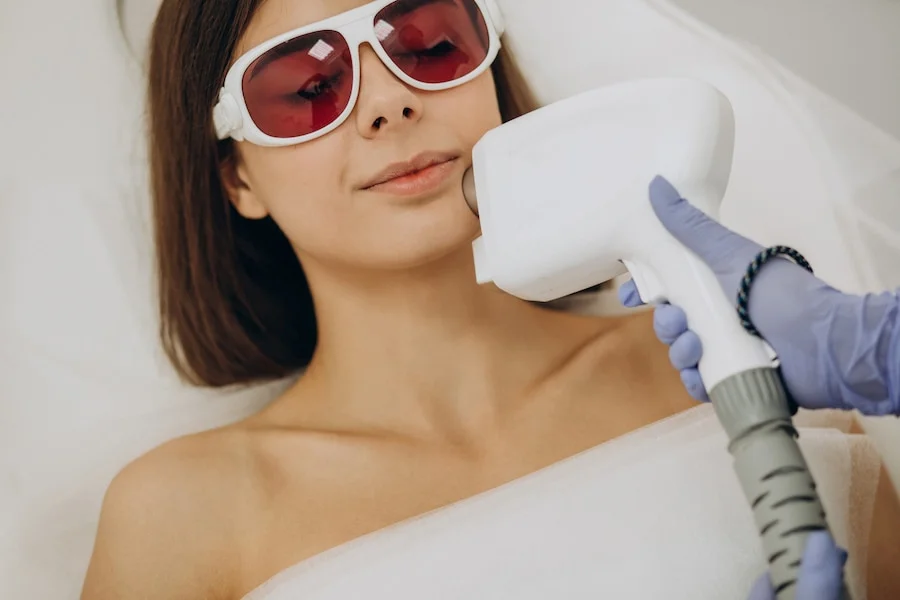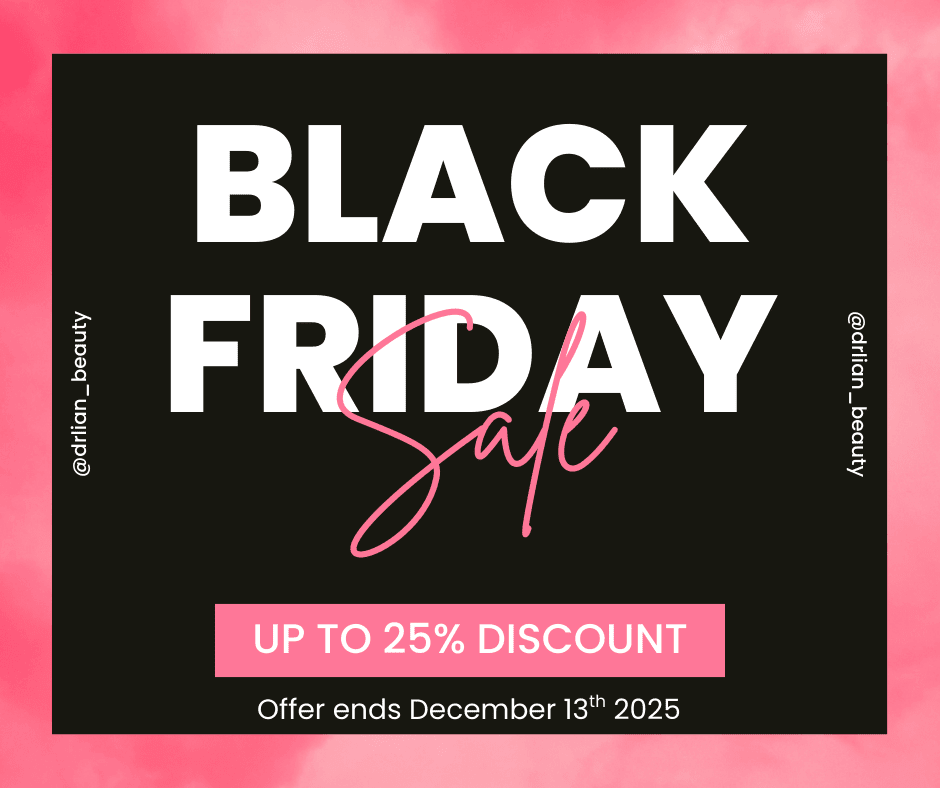Botox has become a popular cosmetic treatment not just among women but increasingly among men as well.
Often dubbed “Brotox,” this treatment involves injecting botulinum toxin into specific muscles to reduce the appearance of wrinkles and fine lines.
As societal attitudes toward cosmetic procedures evolve, more men are exploring Botox as a way to maintain a youthful appearance, boost confidence, and stay competitive in both personal and professional settings.
Table of Contents
ToggleWhat Age Should a Man Get Botox?
Determining the right age to start Botox depends on individual goals and skin conditions. Preventative Botox is recommended for men in their mid-20s to early 30s.
At this stage, it can help prevent the formation of deep lines and wrinkles by relaxing the muscles that cause these expressions.
For men aged 35-50, Botox can effectively reduce the appearance of already formed wrinkles, particularly in areas like the forehead, around the eyes, and between the eyebrows.
This age group often sees the most noticeable benefits from Botox.
While results may vary, even men in their 50s and beyond can benefit from Botox to soften deep lines and rejuvenate their appearance.
Why Men Are Getting Botox

The reasons men opt for Botox are diverse. In a competitive job market, many men use Botox to maintain a youthful and energetic appearance, which can be advantageous in professional environments.
The rise of social media and online dating has increased the pressure to look good.
Men are more conscious of their appearance in photos and profiles, leading them to consider cosmetic enhancements like Botox.
Some men choose Botox to feel more confident in their personal relationships, aiming to look their best for their partners.
Recent research shows that men’s body satisfaction is greatly influenced by how their romantic partners perceive them and the level of sexual intimacy in their relationships.
Common Botox Treatment Areas for Men
Men often opt for Botox in several specific areas: forehead, between the eyebrows (glabella), around the eyes (crow’s feet), and the jawline.
Additionally, Botox is effective for treating certain medical and therapeutic conditions such as jaw clenching or masseter muscle issues, migraines, and excessive sweating (hyperhidrosis), particularly in the armpits, hands, and feet.
What You Need to Know About Botox for Men’s Forehead
Botox on the forehead can significantly reduce the appearance of horizontal lines, giving men a smoother, more youthful look.
Men often have stronger forehead muscles than women, requiring a careful approach to avoid a “frozen” look.
The goal is to soften lines while maintaining a natural range of facial expressions.
Injecting Botox in men’s foreheads requires consideration of muscle mass and natural facial expressions.
A skilled practitioner will use techniques that ensure a subtle, masculine appearance without over-smoothing the skin.
To achieve natural results, it’s crucial to find an experienced provider who understands the nuances of treating male patients.
The number of units and injection sites should be tailored to each individual’s facial anatomy.
What Kind of Men Get Botox?
Botox is popular among men from various professions, including executives, actors, and athletes.
The treatment appeals to those who are regularly in the public eye or those who simply want to maintain a youthful appearance.
According to data from the International Society of Aesthetic Plastic Surgery (ISAPS) and the American Society of Plastic Surgeons, 14.9% of the 9,221,419 Botox procedures performed globally in 2022 were administered to men.
This equates to approximately 1.370 million men receiving Botox treatments, with the remaining 85.1% of procedures being performed on women.
The Benefits of Botox for Men

Botox effectively smooths out wrinkles and fine lines, particularly in the forehead and around the eyes.
Botox can also treat hyperhidrosis, a condition characterized by excessive sweating, particularly under the arms.
The enhanced appearance resulting from Botox can significantly boost a man’s self-confidence, helping them feel more comfortable in both personal and professional settings.
How Long Does Botox Last on a Man?
Botox typically lasts between three to six months.
The duration can vary based on several factors, including the area treated and the individual’s metabolism.
Men generally have larger and stronger facial muscles, which can cause Botox to wear off more quickly.
Younger men might experience longer-lasting effects due to better skin elasticity.
Gender differences also play a role, as men often require larger doses of Botox, which can influence the duration of the results.
Typically, Botox treatments are scheduled every 4-5 months, providing a more rested and youthful appearance—an attractive option for those who remain active in the workplace longer.
Regular treatments can lead to longer-lasting effects as the targeted muscles become weaker over time, reducing the need for frequent injections.
The amount of Botox injected is another important factor; higher doses can potentially extend the duration of the results.
Additionally, a faster metabolism can break down Botox more quickly, reducing its effectiveness period.
Why Is Botox More Expensive for Men?
Due to their generally larger and stronger facial muscles, men often require more units of Botox than women, which can increase the cost of treatment.
The denser muscle mass in men means that achieving the desired effect can sometimes require more product, contributing to the overall expense.
Side Effects and Risks of Botox Injections for Men
Common side effects of Botox include bruising, swelling, and redness at the injection site. These symptoms are usually mild and temporary.
While rare, more serious risks can include drooping eyelids, uneven eyebrows, and muscle weakness. Choosing an experienced and qualified provider is crucial to minimize these risks.
Botox can sometimes yield less-than-ideal results, such as asymmetry or an overly smooth appearance.
However, these issues are typically correctable with follow-up treatments.
What Happens If You Stop Getting Botox?
When considering Botox, many men wonder about the long-term effects and what might happen if they stop treatments. Stopping Botox won’t accelerate the aging process or worsen wrinkles.
Once you discontinue Botox, your facial muscles gradually regain their normal function, and any wrinkles previously treated with Botox will slowly return to their natural state.
Since Botox prevents muscles from contracting and forming deeper lines over time, those who have used it regularly may find that their skin still looks more youthful than if they had never used Botox at all.
Preventative Botox
Preventative Botox has gained popularity as a strategy to prevent the formation of deep wrinkles by treating the skin before visible lines appear.
This approach can be beneficial for maintaining a youthful appearance, especially in areas prone to wrinkles such as the forehead and around the eyes.
However, it’s important to use preventative Botox judiciously. Overuse can lead to muscle weakening and an unnatural, overly smooth appearance, which can, ironically, make a person look older over time.
Therefore, moderation and a conservative approach are crucial.
Myths and Misconceptions About Botox
Botox is often misunderstood, leading to several myths and misconceptions. One common myth is that Botox is solely for cosmetic purposes, but that’s far from the truth.
While Botox is renowned for smoothing out wrinkles and fine lines, it’s also used medically to treat conditions like chronic migraines, excessive sweating (hyperhidrosis), muscle spasms, and even overactive bladder.
This versatility makes Botox a valuable procedure in both aesthetic and medical fields.
Another misconception is that Botox results in a frozen or unnatural look. This fear often arises from seeing poor outcomes due to improper application. In reality, when Botox is administered by an experienced professional, it can create a natural, refreshed appearance.
The key is subtlety and moderation, especially important with preventative Botox, where the goal is to prevent wrinkles without over-treating and risking an unnatural look.
Some people worry that Botox injections are painful. However, the procedure involves very fine needles, and most patients describe the sensation as a minor pinch.
To further ease discomfort, many clinics offer topical numbing creams. The fear of pain should not deter you from considering Botox, as the experience is generally quite tolerable.
Concerns about Botox being toxic or dangerous are also widespread but largely unfounded. Botox is derived from a purified form of the botulinum toxin, and the doses used in cosmetic and medical treatments are safe and Health Canada-approved.
The myth of toxicity likely stems from misunderstanding the nature of the toxin, but rest assured that Botox, when administered by a qualified professional, is a safe treatment option.
Finally, there is the myth that Botox is addictive. Botox itself does not create any chemical dependency.
The desire to continue treatments often stems from satisfaction with the results rather than any form of addiction.
Keep in mind…
The decision to use or stop using Botox is personal and flexible, allowing individuals to control their treatments based on their needs and preferences.
Getting the facts straight about Botox can help you make better choices, whether you’re thinking about it for smoothing out wrinkles, treating a medical issue, or preventing future lines.
It’s a good idea to talk to a qualified professional who can answer your questions and help you figure out if Botox is the right choice for you.
Alternatives to Botox for Men
At Dr. Lian Beauty in Limoges, we offer a variety of treatments that can either complement Botox or serve as alternatives, depending on your individual needs.
Dermal fillers are one such option, used to add volume and smooth out wrinkles and fine lines. Unlike Botox, which relaxes the muscles that cause wrinkles, fillers plump up the skin, making them ideal for areas like the cheeks and lips.
Laser treatments are another alternative that focuses on improving skin texture and tone.
They help reduce the appearance of fine lines, sun damage, and scars by stimulating collagen production, offering a smoother, younger-looking complexion.
Chemical peels exfoliate the top layers of skin, effectively reducing wrinkles, fine lines, and sun damage, and work well in conjunction with Botox to enhance overall results. We also offer Dysport®, another injectable treatment similar to Botox.
Dysport is particularly effective for reducing the appearance of frown lines between the eyebrows and spreads more than Botox, which can be advantageous for treating larger areas.
Each of these treatments provides unique benefits and can be tailored to your specific skin concerns.
If you’re considering any of these options, our medical experts at Dr. Lian Beauty is here to help you decide which treatment is best for you.
Who Should Avoid Botox?
While Botox is a popular and generally safe treatment, it’s not suitable for everyone. People with certain medical conditions or circumstances should avoid Botox to prevent potential complications.
For instance, individuals with neurological disorders like myasthenia gravis or Lambert-Eaton syndrome are at higher risk of side effects because Botox can worsen muscle weakness.
Pregnant or breastfeeding women are also advised to steer clear of Botox, as its safety for the baby has not been established.
Allergic reactions are another concern. Anyone with a known allergy to botulinum toxin or the ingredients in Botox should not undergo treatment. Allergic reactions can range from mild skin irritation to severe anaphylaxis.
Additionally, those with active skin infections or conditions like eczema or psoriasis at the injection site should avoid Botox, as these can increase the risk of infection and complications.
Medications, especially blood thinners and anticoagulants, can lead to increased bruising and bleeding at the injection site.
It’s crucial to inform your healthcare provider about all medications and supplements you’re taking; they may recommend pausing certain medications before the procedure.
If you’ve recently undergone surgery, particularly cosmetic procedures on the face or eyes, it’s best to wait until you’re fully healed before considering Botox to avoid any interference with the recovery process.
Finally, having realistic expectations is key. Botox isn’t a solution for drastic changes or deep emotional issues related to appearance.
A candid discussion with a qualified healthcare professional is essential to ensure Botox is a safe and appropriate choice for you.
What to Expect During a Botox Procedure
When you’re getting Botox, the process is designed to be straightforward and comfortable. It all starts with a consultation where you’ll discuss your goals and medical history with a professional.
This initial meeting, lasting about 30 minutes, helps to set realistic expectations and ensures that the treatment plan is tailored to your needs.
On the day of your procedure, the area to be treated will be cleaned, and a topical anaesthetic might be applied to minimize any discomfort. The actual injections use a fine needle to deliver Botox into specific facial muscles.
Men generally have stronger and thicker facial muscles than women, which means they often require more units of Botox.
For instance, treating forehead lines might need 20-30 units, while crow’s feet typically require 12-16 units across several sites. Frown lines usually involve around 30-40 units.
Common areas for Botox injections in men include the glabella (between the eyebrows), forehead lines, and crow’s feet.
Some men also opt for treatments around the mouth and chin to smooth out lines and dimples. Each injection site is carefully chosen to ensure a natural-looking result and avoid issues like drooping eyebrows.
After the injections, you might notice some redness, swelling, or bruising at the injection sites, but these side effects are usually minor and fade quickly.
The effects of Botox start to become noticeable within a few days, with full results typically appearing around two weeks post-treatment.
The effects generally last between three to four months, after which you can decide if you want to have another treatment.
Post-Procedure Care and Tips
Taking care of your skin after Botox is crucial to get the best results and avoid unwanted side effects. Here’s a simple guide to follow after your treatment:
Right After Your Treatment:
- Light facial exercises, like smiling, frowning, or raising your eyebrows, can help the Botox settle into the muscles. It’s a subtle way to enhance the effects.
- While you don’t need to take time off from work or your usual routine, it’s best to relax for the rest of the day. Skip the gym or any strenuous activities right after your treatment.
- Try not to touch or rub the areas where you had Botox injections. This helps prevent the Botox from spreading to unintended areas.
Getting Back to Normal:
- You can get back to your daily activities right away, but remember to follow some simple aftercare steps to ensure the best results.
- It’s recommended to wait at least 24 hours before resuming your exercise routine. This waiting period helps ensure that the Botox stays where it’s supposed to and reduces the risk of bruising.
- It’s safe and even beneficial to move your facial muscles gently, like smiling or frowning, which can help the Botox settle.
- If you’ve had Botox on your face, it’s a good idea to avoid makeup for the first 24 hours. This gives your skin time to heal and reduces the risk of irritation.
- For the first four hours after your Botox treatment, try to stay upright. Avoid lying down or bending over too much, as this can cause the Botox to move away from the targeted areas.
- If you’re taking any medications or supplements, especially those that can cause bruising, check with your doctor about when it’s safe to resume them. They’ll give you the best advice on how to proceed.
Following these simple steps can help you get the most out of your Botox treatment and ensure a smooth recovery.
Conclusion
Botox offers numerous benefits for men seeking to maintain a youthful and vibrant appearance.
Whether you’re looking to reduce wrinkles, treat medical conditions, or boost your confidence, Botox can be a valuable tool.
The key is to find an experienced provider who understands the unique needs of male patients and can deliver natural-looking results.
At Dr. Lian Beauty, we are committed to providing personalized care to help you achieve your aesthetic goals.
Whether you’re considering Botox or exploring other treatments, we’re here to guide you every step of the way.

Dr. Lian Peter, MD, MPH, CCFP, is a Family physician with a passion for aesthetics. In her aesthetic clinic, she provides a wide range of minimally invasive and non-invasive procedures, constantly honing her skills to deliver exceptional care and help patients attain their desired appearance.






